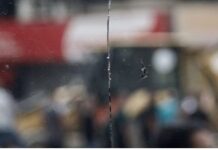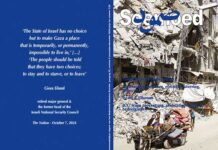Tareq S. Hajjaj
Mondoweiss / November 7, 2024
Civilians fleeing north Gaza are arriving in Gaza City and staying in newly established refugee camps. The camps are already overflowing and there aren’t any more tents.
Hundreds of families gather in Yarmouk Stadium, west of Gaza City. The large stadium’s field is now the site of the first refugee camp to be established in the city, named “Gaza Village.”
Children, women, and men carrying their belongings as they flee the Israeli extermination campaign in north Gaza are streaming into the stadium hoping to find a tent.
The camp was established on October 28, over a year into the Gaza genocide, and currently includes 250 tents. It was not set up by UNRWA, the agency responsible for Palestinian refugees, but through charitable organizations and individuals under the auspices of the Ministry of Development in the Gaza Strip.
The number of displaced people arriving from the northern Gaza Strip has exceeded the camp’s capacity, and not everyone there has a tent. Many families have been sleeping on the stadium’s stands and on the ground, waiting for more tents to arrive.
“The camp was quickly established in response to the displacement of thousands of citizens from north Gaza,” Muhammad Saada, deputy director of the displacement center, tells Mondoweiss. “More than 350 families have arrived from the north, so there aren’t enough tents to accommodate them.”
“The camp relies on individual initiatives and charitable organizations that coordinate with the Ministry of Development, which is the main sponsor of this camp,” he says, emphasizing that these initiatives provide food for the displaced but are neither enough nor ongoing.
The need for food and drinking water is very urgent in the camp, says Saada. “We need to establish a new camp and direct people to it because our number cannot bear an increase. We don’t have any more vacant places. We need new camps.”
With Gaza on the cusp of winter, Saada worries that the camp will not have sufficient preparations to weather the rainy season. “People here are sleeping on terraces; they don’t have blankets or bedding. If it rains, the entire camp will be flooded,” he explains.
“We also don’t have cleaning supplies to distribute to the displaced for fear of the spread of diseases. The situation is tragic. These families were forced by the Israeli army to leave Jabalia and the north, and they reached Gaza City. We do what we can with them, but our capabilities are minimal.”
Mondoweiss contacted Adnan Abu Hasna, the UNRWA representative in the Gaza Strip, who said that he had no knowledge of the camp.
Torment on the death march from north Gaza
Janan Suleiman, 18, was in her home in Beit Lahia when the Israeli army rounded up her family and told them to march south or be shot. The journey to Gaza City on foot took them six hours, and the Israeli army continued to accompany them as soldiers taunted fleeing civilians for a part of the way.
“The tank was moving quickly beside us and covering us with sand,” Jinan tells Mondoweiss. “It kept coming at us from afar so that we thought it would run us over, and they even sometimes blocked our way. I think they were trying to taunt us.”
The details Jinan recounts get more harrowing as she continues to explain how soldiers tormented the women and children and started shooting at their feet. “The soldiers ordered the women and children to stand, and then they started shooting around them. When they ordered us to head south, they started shooting under our feet and above our heads. Each of us ran for a moment, not knowing if our family members were still with us.”
It wasn’t just what happened to Janan personally. She says that what she saw on her way was difficult to witness, with corpses littering the evacuation route. She also says that the other displaced people she encountered on her way to Gaza City were in desperate conditions.
“There was a lady with cancer standing on the side of the road, and she had four children with her,” Jinan says. “She was carrying two of them in her arms, and two others were on the ground crying and screaming from hunger. She was asking for help from anyone who passed by her. She was screaming and saying, ‘I have cancer, I can’t carry my children and my bags.’”
“She wanted someone to take her children, who were lying on the ground, but I, like everyone else, passed by her and couldn’t help her,” Jinan continues.
She explains why no one could help the woman. The army wouldn’t allow it, Jinan says. “The soldiers were lying in wait for us, shooting under our feet and preventing us from helping others or from standing for any reason.”
“I saw another lady carrying her daughter who was no more than a week old. She could barely walk, and she said that her daughter hadn’t breastfed since yesterday and she needed someone to support her and help her walk until we reached Gaza City. But the soldiers also prevented anyone from helping her,” Jinan explains.
‘They want to destroy the north’
Umm Omar Salman, a teacher, gathers high school students like Jinan around her and tries to help them prepare for the February high school exams. In a tent, she sits surrounded by students, using empty buckets of water instead of tables to write on.
Umm Omar says that she came to the camp so that she could return to north Gaza if the army withdraws. She says she had no intention of leaving the northern Gaza Strip, but was forced to at gunpoint. “We have been steadfast in our homes in Beit Lahia since the beginning of the war. We were displaced to the schools in Beit Lahia so that we would not leave our land.”
“But the Israeli army is implementing the Generals’ Plan against us, and we know that they want to eradicate everything,” Umm Omar says.
The “Generals’ Plan” refers to a proposal put forward by a group of senior Israeli generals based on the vision of retired general Giora Eiland, articulated early on in the war, which would empty out northern Gaza of as many people as possible and then consider anyone who remains an enemy combatant. The Generals’ Plan would then move to kill them through bombardment or starvation.
“They want to destroy the north,” Umm Omar says. “Especially the border area, Beit Lahia. It’s where we’re from. We held out until the last possible moment, when we found dozens of tanks surrounding the school shelters. The soldiers forcibly removed us.”
Umm Omar says that the Israeli army had sent a quadcopter drone into the school they were staying in. The drones blared the army’s orders through loudspeakers, she says, saying that this was their last chance and that it was a “final warning.”
“They used all means of intimidation and terror against us, but we held out until our last breath,” Umm Omar tells Mondoweiss.
The Israeli army ordered the displaced to leave through a specific road, which was rough and full of ditches that the military had dug up to exhaust the displaced, Umm Omar says. “After we were expelled, they would shoot anyone who tried to remain in the north by escaping through a different route than the one that had been set by the Israeli army.”
“On the way, the injured were walking together, bleeding; they fell in the middle of the road, and no one helped them,” Umm Omar says. “There were children who lost their families, and there were those who got rid of their bags so they could keep walking and survive.”
“The army deliberately made us walk through a rough road so they could exhaust us and kill us on the way,” she explains.
Umm Omar and her eight family members arrived in Gaza City and found this camp after days of trying to find shelter.
“If the Israeli army withdraws from Jabalia and Beit Lahia, we will take what we brought from home and return,” she vows.
Tareq S. Hajjaj is the Mondoweiss Gaza Correspondent, and a member of the Palestinian Writers Union
Hashem Alsaudi gathered testimonies for this report












